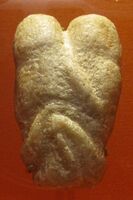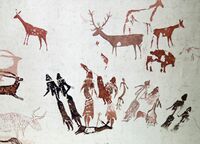العصر الحجري الوسيط
| ||||||||||||||
| ||||||||||||||
| ||||||||||||||
العصر الحجري الوسيط أو «الميزوليت» mesolithic مصطلح يوناني الأصل، يتألف من «mesos» وتعني وسيط و«lithos»، وتعني حجر، استُخدم منذ نهاية القرن التاسع عشر للدلالة على العصر الحجري الوسيط، الذي يفصل بين العصر الحجري القديم «الباليوليت» الذي سبقه والعصر الحجري الحديث «النيوليت» الذي تبعه.
يختلف الإطار الزمني والمضمون الحضاري لهذا العصر حسب المناطق، وهو يبدأ في الشرق الأوسط منذ نحو 12ألف سنة ق.م، ويستمر حتى 10آلاف سنة ق.م.
يتميز العصر الحجري الوسيط، الذي يُطلق عليه أيضاً في أوربا وإفريقيا «الباليوليت التالي» epi-paleolithique بظهور الأدوات الحجرية الصغيرة جداً، الميكروليتية، ذات الأشكال الهندسية microlithes-geometriques، التي أنتجتها حضارات عدة في مختلف الأمكنة والأزمنة. سادت في الجزء الأول من هذا العصر، في الشرق الأوسط، الحضارة الكبارية الهندسية Kebarien geometrique التي تطورت عن الحضارة الكبارية، نسبة إلى مغارة الكبارا في فلسطين، التي ظهرت في نهاية الباليوليت. لقد انتشر الكباريون الهندسيون على مساحات واسعة في المشرق العربي القديم، وحملوا صفات مشتركة بين المجتمعات التي سبقتهم، وتلك التي أتت بعدهم، فكانوا شبه مستقرين، بنوا الأكواخ والبيوت البسيطة إلى جانب سكنهم المغاور والملاجئ الطبيعية، وجمعوا النباتات وصادوا الحيوانات البرية التي دُجِّنت في العصر اللاحق. استخدموا الأدوات المركبة، الميكروليتية - الهندسية والأدوات البازلتية، ومارسوا الفنون البسيطة التي دلت عليها مواقعهم في بلاد الشام، مثلهم مثل إخوانهم الزارزيين في بلاد الرافدين (نسبة إلى موقع زارزي في شمالي العراق).
وفي النصف الثاني من العصر الحجري الوسيط عاش النطوفيون، نسبة إلى وادي الناطوف في فلسطين، الذين تطوروا عن الكباريين الهندسيين، وزادوا عليهم في مختلف المجالات، فكانوا أول من أنشأ قرى الصيادين الأولى التي ضمت تجمعات بشرية أكبر من أي وقت مضى. وكانوا أكثر مهارة في نشاطهم الاقتصادي في الصيد والالتقاط، وفي نشاطهم التقني في تصنيع الأسلحة والأدوات الميكروليتية الهندسية والعظمية والبازلتية الكبيرة وغيرها. وقد ظهرت لديهم، أول مرة، الفنون بمعناها الحقيقي، التي جسدتها الدمى الإنسانية والحيوانية والحلي والأدوات، وكانوا أول من بنوا المقابر ومارسوا شعائر دفن متميزة. لقد جسّد النطوفيون أبكر وحدة حضارية، ربطت بين مختلف أرجاء المشرق العربي القديم، دلت عليها آثارهم التي انتشرت من وادي النيل غرباً حتى حوض الفرات شرقاً، وكانوا آخر مجتمعات الصيد والالتقاط التي بلغت سوية تطور عالية، مهدت الطريق لظهور المجتمعات الزراعية الأولى في نهاية الألف العاشرة ق.م.
المصطلحات

أوروپا


بعض مواقع العصر الحجري الوسيط الجديرة بالذكر:
- Lepenski Vir، صربيا — 7000 ق.م.
- ستار كار، إنگلترة وستار كار هاوس — 8700 ق.م.
- Pulli settlement، إستونيا — 9000 ق.م.
- Franchthi cave, Greece — 20,000–300 ق.م.
- Cramond, Scotland — 8500 ق.م.
- Mount Sandel، أيرلندا — 7010 ق.م.
- Howick house, إنگلترة — 7000 ق.م.
- Newbury، إنگلترة
- Swifterbant culture، هولندا
- Aveline's Hole، سمرست، إنگلترة — 8000 ق.م.
- Ngwenya Mine، سويسرا - 42,000 ق.م.
- Nanzhuangtou bog, الصين - 8500-7700 ق.م.
- Rock Shelters of Bhimbetka، الهند
- Shigir Idol, روسيا - 7500 ق.م.
The Ain Sakhri lovers; c. 9000 BCE (late Epipalaeolithic Near East); calcite; height: 10.2 cm, width: 6.3 cm; from Ain Sakhri (near Bethleem, Israel); British Museum (London)
Roca dels Moros, Spain, The Dance of Cogul, tracing by Henri Breuil
Cultures
| العصر الحجري الوسيط Epipaleolithic |
|---|
| ↑ العصر الحجري القديم |
| ↓ العصر الحجري الحديث ↓ العصر الحجري |
| Geographical range | Periodization | Culture | Temporal range | Notable sites |
|---|---|---|---|---|
| Southeastern Europe (Greece, Aegean) | Balkan Mesolithic | 15,000–7,000 BP | Franchthi, Theopetra[3] | |
| Southeastern Europe (Romania/Serbia) | Balkan Mesolithic | Iron Gates culture | 13,000–5,000 BP | Lepenski Vir[4] |
| Western Europe | Early Mesolithic | Azilian | 14,000–10,000 BP | |
| Northern Europe (Norway) | Fosna-Hensbacka culture | 12,000–10,500 BP | ||
| Northern Europe (Norway) | Early Mesolithic | Komsa culture | 12,000–10,000 BP | |
| Central Asia (Middle Urals) | 12,000–5,000 BP | Shigir Idol, Vtoraya Beregovaya[5] | ||
| Northeastern Europe (Baltics and Russia) | Middle Mesolithic | Kunda culture | 10,500–7,000 BP | Lammasmägi, Pulli settlement |
| Northern Europe | Maglemosian culture | 11,000–8,000 BP | ||
| Western and Central Europe | Sauveterrian culture | 10,500–8,500 BP | ||
| Western Europe (Great Britain) | British Mesolithic | 11,000–5,500 BP | Star Carr, Howick house, Gough's Cave, Cramond, Aveline's Hole | |
| Western Europe (Ireland) | Irish Mesolithic | 11,000–5,500 BP | Mount Sandel | |
| Western Europe (Belgium and France) | Tardenoisian culture | 10,000–5,000 BP | ||
| Central and Eastern Europe (Belarus, Lithuania and Poland) | Late Mesolithic | Neman culture | 9,000–5,000 BP | |
| Northern Europe (Scandinavia) | Nøstvet and Lihult cultures | 8,200–5,200 BP | ||
| Northern Europe (Scandinavia) | Kongemose culture | 8,000–7,200 BP | ||
| Northern Europe (Scandinavia) | Late Mesolithic | Ertebølle | 7,300–5,900 BP | |
| Western Europe (Netherlands) | Late Mesolithic | Swifterbant | 7,300–5,400 BP | |
| Western Europe (Portugal) | Late Mesolithic | 7,600–5,500 BP |
"الحجري الوسيط" خارج غرب أوراسيا
| Geographical range | Periodization | Culture | Temporal range | Notable sites |
|---|---|---|---|---|
| North Africa (Morocco) | Late Upper Paleolithic to Early Mesolithic | Iberomaurusian culture | 24,000–10,000 BP | |
| North Africa | Capsian culture | 12,000–8,000 BP | ||
| East Africa | Kenya Mesolithic | 8,200–7,400 BP | Gamble's cave[6] | |
| Central Asia (Middle Urals) | 12,000–5,000 BP | Shigir Idol, Vtoraya Beregovaya[7] | ||
| East Asia (Japan) | Jōmon cultures | 16,000–1,350 BP | ||
| East Asia (Korea) | Jeulmun pottery period | 10,000–3,500 BP | ||
| South Asia (India) | South Asian Stone Age | 12,000–4,000 BP[8] | Bhimbetka rock shelters, Lekhahia |
- Caucasian Hunter-Gatherer
- History of archery#Prehistory
- List of Stone Age art
- Mammoth extinction
- Western Hunter-Gatherer
- Younger Dryas
انظر أيضاً
- فترة جومون
- الألفية العاشرة ق.م.
- الألفية التاسعة ق.م.
- الألفية الثامنة ق.م.
- الألفية السابعة ق.م.
- هولوسين
الهامش
- ^ Zalloua, Pierre A.; Matisoo-Smith, Elizabeth (6 January 2017). "Mapping Post-Glacial expansions: The Peopling of Southwest Asia". Scientific Reports (in الإنجليزية). 7: 40338. Bibcode:2017NatSR...740338P. doi:10.1038/srep40338. ISSN 2045-2322. PMC 5216412. PMID 28059138.
- ^ Morgan, C.; Scholma-Mason, N. (2017). "Animated GIFs as Expressive Visual Narratives and Expository Devices in Archaeology". Internet Archaeology (44). doi:10.11141/ia.44.11.
- ^ Sarah Gibbens, "Face of 9,000-Year-Old Teenager Reconstructed", National Geographic, 19 January 2018.
- ^ Srejovic, Dragoslav (1972). Europe's First Monumental Sculpture: New Discoveries at Lepenski Vir. ISBN 978-0-500-39009-2.
- ^ Central Asia does not enter the Neolithic, but transitions from the Mesolithic to the Chalcolithic in the fourth millennium BC (metmuseum.org). The early onset of the Mesolithic in Central Asia and its importance for later European mesolithic cultures was understood only after 2015, with the radiocarbon dating of the Shigor idol to 11,500 years old. N.E. Zaretskaya et al., "Radiocarbon chronology of the Shigir and Gorbunovo archaeological bog sites, Middle Urals, Russia", Proceedings of the 6th International Radiocarbon and Archaeology Symposium, (E Boaretto and N R Rebollo Franco eds.), RADIOCARBON Vol 54, No. 3–4, 2012, 783–94.
- ^ "Africa-Paleolithic". Britannica. Retrieved 28 November 2018.
- ^ Central Asia does not enter the Neolithic, but transitions from the Mesolithic to the Chalcolithic in the fourth millennium BC (metmuseum.org). The early onset of the Mesolithic in Central Asia and its importance for later European mesolithic cultures was understood only after 2015, with the radiocarbon dating of the Shigor idol to 11,500 years old. N.E. Zaretskaya et al., "Radiocarbon chronology of the Shigir and Gorbunovo archaeological bog sites, Middle Urals, Russia", Proceedings of the 6th International Radiocarbon and Archaeology Symposium, (E Boaretto and N R Rebollo Franco eds.), RADIOCARBON Vol 54, No. 3–4, 2012, 783–794.
- ^ The term "Mesolithic" is not a useful term for the periodization of the South Asian Stone Age, as certain tribes in the interior of the Indian subcontinent retained a mesolithic culture into the modern period, and there is no consistent usage of the term. The range 12,000–4,000 BP is based on the combination of the ranges given by Agrawal et al. (1978) and by Sen (1999), and overlaps with the early Neolithic at Mehrgarh. D.P. Agrawal et al., "Chronology of Indian prehistory from the Mesolithic period to the Iron Age", Journal of Human Evolution, Volume 7, Issue 1, January 1978, 37–44: "A total time bracket of c. 6,000–2,000 B.C. will cover the dated Mesolithic sites, e.g. Langhnaj, Bagor, Bhimbetka, Adamgarh, Lekhahia, etc." (p. 38). S.N. Sen, Ancient Indian History and Civilization, 1999: "The Mesolithic period roughly ranges between 10,000 and 6,000 B.C." (p. 23).
للاستزادة
- Dragoslav Srejovic Europe's First Monumental Sculpture: New Discoveries at Lepenski Vir. (1972) ISBN 0-500-390-096
وصلات خارجية
- Official Lepenski Vir Site in Serbian
- Mesolithic Miscellany — Newsletter and Information on the European Mesolithic
- 20th Century Mesolithic Sites in Mandla (Madhya Pradesh), India, discovered by Dr. Babul Roy: [1], [2], and [3]
- Picture Gallery of the Paleolithic (reconstructional palaeoethnology), Libor Balák at the Czech Academy of Sciences, the Institute of Archaeology in Brno, The Center for Paleolithic and Paleoethnological Research
- Gazetteer of Mesolithic sites in England and Wales with a gazetteer of Upper Palaeolithic sites in England and Wales. Wymer JJ and CJ Bonsall, 1977 Council for British Archaeology Research Report No 20
- UNESCO World Heritaga Site in India - Rock Shelters of Bhimbetka



![Animated image showing the sequence of engravings on a pendant excavated from the Mesolithic archaeological site of Star Carr in 2015[2]](/w/images/thumb/c/c9/Star_Carr_Engraved_Pendant.gif/142px-Star_Carr_Engraved_Pendant.gif)

